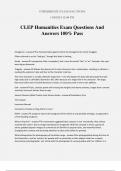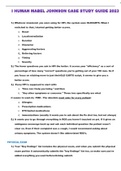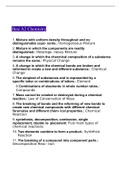©THEBRIGHT EXAM SOLUTIONS
11/8/2024 12:08 PM
CLEP Humanities Exam Questions And
Answers 100% Pass
Antagonist - answer✔The character/idea against whom the protagonist (or hero) struggles.
Often referred to as the "bad guy", though this label is limiting.
Simile - answer✔A comparison (like a metaphor), but it uses the words "like" or "as". Example: Her eyes
were big as diamonds.
Tragedy - answer✔It follows the descent of its main character into a catastrophe, resulting in catharsis—
evoking the audience's pity and fear at the character's demise.
The main character is usually called the tragic hero—one who begins the play with great potential and
high status but is ultimately doomed to fail, often because of a tragic flaw in his character. The tragic
flaw most often seen in Greek literature is hubris, or excessive pride in one's own abilities.
Ode - answer✔A lyric, stanzaic poem with varying line lengths and rhyme schemes, longer than a sonnet
certainly, but much shorter than an epic.
Samuel Clemens (Mark Twain) most famous books - answer✔Huckleberry Finn
Tom Sawyer
Innocents Abroad
Connecticut Yankee in King Arthur's Court
Relief - answer✔A sculpture tied to the background from which it only partially emerges, as opposed to
a free-standing sculpture.
What is Pop Art? - answer✔This movement suggested that a picture is not "essentially a flat surface
covered with colors" but an image wanting to be recognized. With this concept in mind, a group of
artists grabbed popular images of commercial art familiar to popular taste, and reworked them,
changing their context and attracting attention to that easily taken for granted.
What distinguishes the photography of Dorothea Lange - answer✔She photographed during the time of
the Depression, and her concern for people and her sensitivity to their plights made her a superb
documentary photographer. Her article with the photograph of a young widow with her children in a
, ©THEBRIGHT EXAM SOLUTIONS
11/8/2024 12:08 PM
migrant workers' camp with 2,500 virtually starving migrant workers in California made the government
respond by rushing in food and workers' relief camps emerged.
Which are the register for female and male voices? - answer✔Female vocal registers consist of:
• soprano (high)
• mezzo-soprano (medium)
• alto/contralto (low/lowest).
The male vocal registers are:
• tenor (high)
• baritone (medium)
• bass (low)
Dance - answer✔It can be defined as patterned and rhythmic body movements to the accompaniment
of music or other rhythmic sounds for the purpose of telling a story or communicating emotions, themes
or ideas. Dancing can serve many functions such as ritual, courtship, religious celebrations, worship, art,
entertainment, recreation, rites of passage and socialization.
Om (also Aum or Pranava): - answer✔It is the most important and sacred Hindu syllable. It is an
elongated sound thought to contain all things and believed to be the sound through which the universe
was created. It is chanted at the beginning of many prayers and blessings
Allegory - answer✔A form of extended metaphor in which objects, persons, and actions in a story that
lie outside the story. The story has two meanings, a literal and a symbolic meaning. The meanings have a
moral, social, religious, or political significance.
Alliteration - answer✔Repetition of an initial consonant. Two forms:
Assonance: Identity or similarity in sound between internal vowels in neighboring words.
Consonance: The final consonant sounds of accented syllables or important words.
Antithesis - answer✔Opposite phrases in close conjunction, a contrast of opposites or a contrast of
degree
Archetype - answer✔Original model or pattern from which copies are made. Includes a symbol, theme,
setting, or even an entire human race.
Backdrop - answer✔a curtain or scenery at the back of a stage
, ©THEBRIGHT EXAM SOLUTIONS
11/8/2024 12:08 PM
Bildungsroman - answer✔A German word referring to a novel structured as a series of events that take
place as the hero travels in quest of a goal
Canon - answer✔A collection of works and authors who have the seal of approval from academic and
cultural establishments.
Climax - answer✔That point in a plot that creates the greatest intensity, suspense, or interest; usually
the point at which the conflict is resolved
Doppelganger - answer✔A double or look alike of a living person that typically represents evil.
Epilogue - answer✔A final chapter at the end of a story that usually brings closure to the story.
Euphemism - answer✔The substitution of an inoffensive term for one considered offensive. Ex. Passed
away instead of died.
Inflate or magnify rather than cover up, making something sound more important. Ex. Technical
representative for salesperson
Flashback - answer✔A narrative technique that presents past events during current events in order to
provide background.
Foreshadowing - answer✔An author's use of hints or clues to suggest events that will occur later in the
story
Hyperbole - answer✔A figure of speech or extravagant statement not intended to be taken literally
Imagery - answer✔Mental images, figures, or likenesses of things; the use of language to represent
actions, persons, objects, and ideas descriptively. Uses the senses rather than just forming a mental
image.
Irony - answer✔A contrast between expectation and reality.
Verbal irony: A discrepancy between what is said and what is meant.
Structural irony: Involves someone whose view of the world differs from the true circumstances.
Dramatic irony: The audience knows more about the character than the character himself.
Narrator - answer✔The person who tells the story
Nemesis - answer✔A person's worst enemy
Onomatopoeia - answer✔A word that imitates the sound it represents
Parable - answer✔Short story with a moral lesson or religious principle at the end
Personification - answer✔Giving human traits to non-living objects
, ©THEBRIGHT EXAM SOLUTIONS
11/8/2024 12:08 PM
Plot - answer✔The events or main story of what happens in a drama or story.
Poetic Speaker - answer✔"Persona"-the narrator or speaker of a poem, not the author
Prologue - answer✔An introduction calling attention to the theme of a play
Proscenium - answer✔The frame or arch separating the auditorium from the stage, where the action of
a play is viewed
Protagonist - answer✔Main character in a story
Rhyme - answer✔A pattern of repeated sounds
Rhyme Scheme - answer✔Pattern of rhymed words throughout a poem expressed in alphabetic terms.
Stanza - answer✔A series of one or more lines grouped together but separated from other groups of
lines in the poem by a blank line
Stream of Consciousness - answer✔A literary technique that presents the thoughts and feelings of a
fictional character; the form of written text that is neither entirely verbal nor textual
Symbol - answer✔An object or action in a literary work that stands for or points to a reality beyond
itself.
Theme - answer✔A central idea or insight about life or human behavior that a story reveals; may be
stated or implied. Differs from the subject or topic of a literary work.
Tone - answer✔The mood and attitude present in a work
Verisimilitude - answer✔When a writer presents details that shows the truth about a tale
Allegory - answer✔A form of narrative that doubles as an extended metaphor
Aside - answer✔A speech given by a character that is directed specifically to the audience or reader and
not heard by other characters
Allusion - answer✔Reference to one literary work in another.
Alliteration - answer✔The repetition of initial sounds in consecutive or nearby words. "Sklark,Scanted",
"Free,Fells"
Anaphora - answer✔The intentional repetition of a word or phrase at the beginning of a number of
consecutive verses, clauses or paraphrases
Blank Verse - answer✔a type of verse made up of unrhymed lines in the same meter, often iambic
penameter
Denouement - answer✔The final resolution of the conflict in a story






